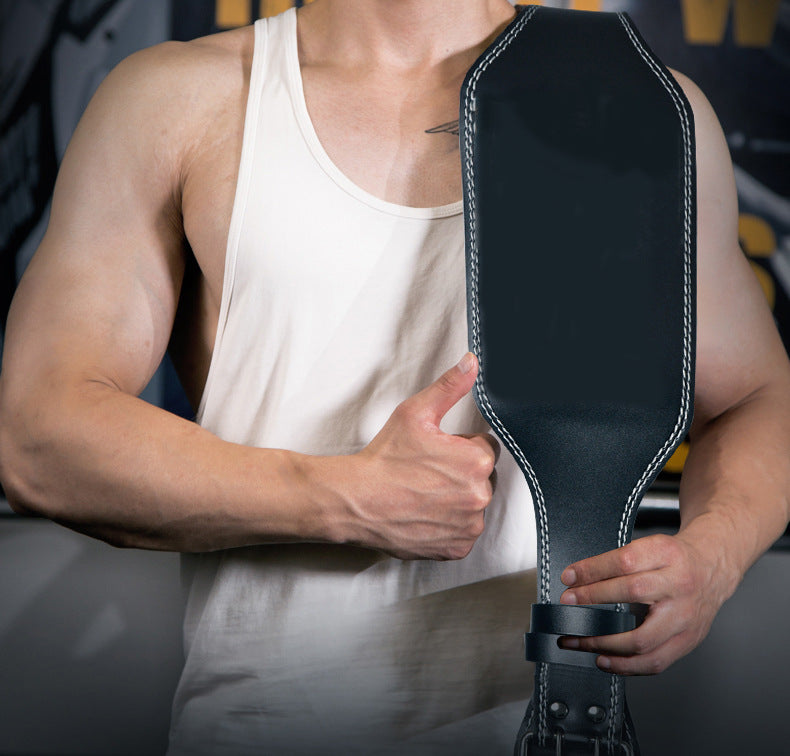
Weightlifting belts are designed to help provide support around your lower back when performing numerous heavy lifting exercises, such as: deadlifts, overhead presses, squats and clean-and-jerks. Some would argue that if you're lifting that heavy, then you should have a core that's able to withstand such pressures, but that kind of misses the point. Weightlifting belts aren't built to help mask the core strength that you are lacking – that would be a recipe for disaster. Instead, by creating a little intra-abdominal and thoracic pressure, a good weightlifting will help you stay more stable throughout the lift. Remember, if you are suffering from a bad back or any muscular imbalances, then this needs to be addressed before you start lifting big.
Do I Need a Weightlifting Belt?
Moreover, do they justify the hefty price tag? Frankly, it depends who you ask. There are certainly a few myths and misconceptions about weightlifting belts. Some feel that they actually weaken your core and lower back, while others believe it's a form of “cheating” is another. A significant majority within the strongman community, however, disagree, with many of its athletes swearing by the benefits of the belt.
“Although many people argue that weightlifting belts are a crutch at best and useless at worse, their usage has stood the test of time,” says MH’s Fitness Editor Andrew Tracey. “Many arguments against their validity do hold water, but most of them focus on the wrong factors. Belts are a great tool, but like all tools, they need to be used properly, and for the right job.
“If you’re a new lifter, a weight belt is probably completely unnecessary,” he continues. “You should focus your efforts on lifting progressively heavier weights with perfect form. However as your strength grows, particularly in the big compound lifts like the squat and the deadlift, you may find that your core doesn’t respond as quickly as the muscles of your lower body, when this happens a belt could allow you to keep pushing the weights up (safely) by giving your core a boost.”
How Does a Weightlifting Belt Work?
Before you decide whether a weightlifting belt is the missing chink in your workout armour, you should first understand how it works. You might not even realise you’re doing this, but you brace your body for a heavy lift by taking a deep breath and holding it in. This action has a name – the Valsalva manoeuvre – and its function is to cushion and stabilise your spine by creating intra-abdominal pressure to keep your form locked in. According to one study published in the journal Medicine and Science in Sports and Exercise, this pressure is greater and accumulates quicker with a belt compared to without.
“A correctly-positioned belt gives our abdominal muscles something to ‘push against’, creating up to 40% more pressure and stability, further lowering the risk of injury,” Tracey adds. “Belts also provide a great tactile cue to ensure that you’re bracing your core correctly. Having something to actively ‘breathe into’, can help you to properly activate the muscles of your core, as well giving you a better sense of the position of your back. The belt will give you tactile feedback if you begin to flex too much in a deadlift, or extend too much during an overhead press – this can help you to avoid injuries and smash PBs.”
When to Consider Using a Weightlifting Belt?
According to Mike Lee, CEO of CrossFit London, you should consider using a weightlifting belt when performing the big compound movements, particularly deadlifts, squats and cleans. “These are ultimately the three heaviest movements that can be performed by the body and have the highest risk of injury if performed often at maximal load or incorrectly.”
Weightlifting Belts Will Not Work Miracles
Yes, it will help you lift heavier but it won’t fix poor form – that’s on you. “A belt will give you more support, but it won’t help if you still move badly,” explains Mike Causer, head coach at London Olympic Weightlifting Academy.
“My recommendation is to spend the majority of your training using your core as your primary bracing tool,” says Lee, “and add a belt at higher percentages or in particularly high-volume phases if you believe your core will be a limiting factor.”
What Should You Look for in a Weightlifting Belt?
It should sit around your waist, rather than your hips – so when you’re ordering online, make sure to measure up rather than defaulting to your usual jeans size. Then there’s the fabric and fastening to consider.
Generally, a neoprene belt will suit most gym-goers, says Lee. Powerlifters should look for “leather, something hard-wearing and more rigid,” he explains, while Olympic weightlifters will benefit from “something in-between – the flexibility of a general use belt as the movements are more dynamic, with the rigidity that still allows for movement of a greater load.”
When it comes to fastenings, the double-prong belt is “good for squats and deadlifts, but doesn’t offer the flexibility and freedom of movement for snatches and cleans and jerks,” Causer advises. “Single-prong leather belts tend to offer more support and core stabilisation, while neoprene belts keep warmth in the back and offers light support,” he adds.


